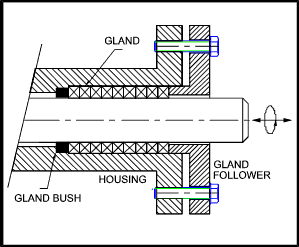Packings
Introduction The packed gland is used primarily for sealing process valve shafts (axial movement) and for process pump shafts(rotary movement). The packed gland has provided a low tech. convenient solution throughout the history of engineering. In modern times the packed gland is being replaced by more exotic solutions. Typical Packed Gland Arrangement The packed gland seal for pump applications is now rarely fitted to new pumps. This is due to it's high maintenance requirements. When fitted it is mostly used in conjunction with long coupled bed plate mounted pumps. Specific operating conditions require distinctly different types of packed gland seals. They require regular checks and maintenance adjustments.. Proper lubrication of the gland packing requires a certain leakage rate. Special manufacturers recommendation's are to be observed individually. Service life expectancy is between 1 and 2 years, this can sometimes extend to several years on favourable conditions. Extremely bad fluid conditions (sediments, additives, overheating) can however drastically cut short their service life. Packed glands should preferably be used in conjunction with shaft sleeves in order to avoid damage to the shaft by aggressive fluids or due to improper treatment of the packed gland. Valves The packed gland is still widely used for stem sealing of various types of
valves including gate valves, globe valves, and ball valves. The packed gland provides a low cost
option with the capabilities of sealing under a wide range of operating conditions with a wide range of
fluids by selecting appropriate packing materials. A packed gland is often used in conjunction
with another type of seal or fluid containment e.g an o-ring seals, bellows containment etc. General The properties of a packing system required for good sealing and trouble free operation include
Soft Packings Yarn packings can be based on vegetable , animal or synthetic fibres and are based on various types of fibre.
Metallic Packings In plaited and braided packings reinforcing wires are used for operation at higher
temperatures and pressures. For high temperatures, woven types of copper and
aluminium packing can be produces. Metal foils of lead, aluminium, and copper can be
used to form packings. Lantern Rings Annular rings are sometimes included between two sets of packings to allow introduction of lubricant, cooling or flushing fluid. Shaft Design The shaft/ sleeve surface in contact with the seal should have a surface finsh of 0.4 micrometres or better. The clearances above and below the packings should be such to prevent extrusion of the packing material along the shaft. The clearance should not be too small that contact between the static and rotating metal is possible Temperature Range For Packing Materials Table provided for guidance only, final design values must be obtained from suppliers
Surface Velocity Range For Packing Materials Table provided for guidance only, final design values must be obtained from suppliers
|
Links Providing information on Packings
|
|
